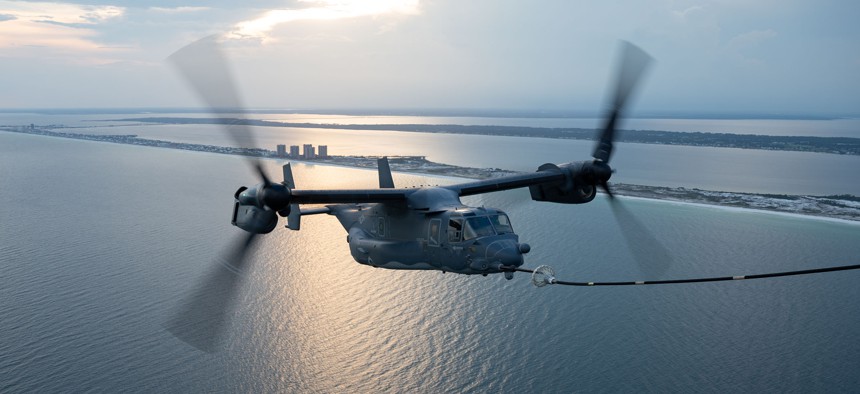
A CV-22 Osprey refuels from an MC-130J Commando II over the Emerald Coast during Operation Centennial Contact, June 27, 2023. U.S. Air Force / Senior Airman Natalie Fiorilli
Air Force weighs future of Osprey as months-long grounding continues
The tiltrotor’s suspension has given the Marines an “operational gap.”
The Air Force has launched a “comprehensive review” of its CV-22 force after a deadly crash killed eight airmen and the Pentagon grounded its entire fleet of Ospreys.
The review will determine whether the CV-22 force is “appropriately organized, trained and equipped for safe, effective, and efficient special operations,” said Air Force Special Operations Command chief Lt. Gen. Tony Bauernfeind.
The command also is conducting two other reviews to determine the cause of the crash: a safety investigation board and an accident investigation board. Only the latter will be made public, Bauernfeind told reporters Tuesday at the Air & Space Forces Association Warfare Symposium.
The Pentagon grounded its Ospreys on Dec. 6 after an Air Force CV-22 crashed off the coast of Japan due to a “materiel failure” with the aircraft.
Bauernfeind said it’s still too soon to speculate on the root cause or findings from the investigations.
“When we make that decision to return to fly, it will be with me having full confidence not only in our training, but our crews, as well as the platform and new mitigation measures that we have in place to ensure that we can react appropriately if another situation develops,” he said.
Bauernfeind wouldn’t say which aircraft his command is using while the Ospreys are grounded, but said, “they have leveraged other joint force capabilities to meet the requirements.”
Other Pentagon aircraft that can meet similar lift needs include the CH-53 and CH-47.
The Ospreys fill an important role, Bauernfeind said, but AFSOC acknowledges that the V-22 is “1980s technology” and the service is reviewing what could provide the “next generation of capability.” For example, DARPA is developing an experimental vertical takeoff and landing aircraft that can fly much faster than the Osprey.
“DARPA solves extremely hard problems, but it also takes time if they prove a concept and now turn that to production,” he said.
Separately, the Marine Corps—the primary user of the V-22—is dealing with an “operational gap” because the 26th Marine Expeditionary Unit, which is currently deployed in the Eastern Mediterranean, cannot fly its Ospreys. But if a “crisis” does break out, the service has “authorities” to start flying the V-22 again, said Gen. Christopher Mahoney, assistant commandant of the Marine Corps.
The service has been cycling Osprey pilots through flight simulators to keep them fresh on the platform while the grounding continues, Mahoney said Thursday at the WEST 2024 conference.
“We're leaning as far forward as we can, based on the authorities that we have, [so] when we get either an interim flight clearance or flight clearance, we will be ready to go,” Mahoney said.
Mahoney reiterated that his confidence in the aircraft is “extremely high.”
Lauren Williams contributed to this report.





